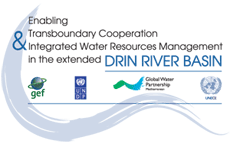Buna/Bojana River sub-basin the coastal zone and the adjacent marine area
The Buna/Bojana River -which is 44 km long with a depth that varies from 2 m to 4 m- is the only outflow from Lake Skadar/Shkodër. Discharges from Lake Skadar/Shkodër combine with flows from the Drin River about 1.5 km from the lake to produce a mean annual discharge of over 20km3 yr-1.
Sometimes the outflow from the lake into the Buna/Bojana River is impeded due to an increase in the flow of the Drin River. This occurs mostly from December to February, but may also occur throughout the rest of the year, depending on the water released from the three hydropower dams upstream of the Drin River.
The management of the dams depends on rainfall and electricity demand. The restriction to out-flowing water in the Buna/Bojana River significantly increases the lake's water level. With high Drin River water levels and low Buna/Bojana River water levels, Drin River water can enter the lake. The Drin River also deposits sediment, thereby further obstructing the flow in the Buna River and the outflow from the lake.
Land-use changes adjacent to the river channel have reduced the area of the floodplain, altering ecosystem structures and the hydrology of the river. Before the intensive drainage and melioration of the area, almost 50 percent of the whole Buna/Bojana River and Delta region was regularly flooded.
The Buna/Bojana Delta area comprises a recently developed small delta, several different lagoon complexes and freshwater lakes, as well as typical riverine and coastal landscapes. The growth of the delta by 1.0-1.5 km in the last 100 years is relatively slow compared with other Mediterranean deltas, such as the Rhone and Po (about 4 km in 100 years).
Lake Šaško and Viluni Lagoon are important wetlands in terms of biodiversity. Lake Šaško is situated within the Montenegrin part of the Buna/Bojana Basin (Ulcinj Field) and is fed by the Buna/Bojana River under favourable hydrological conditions. The lake is approximately 3 km long and 1.5 km wide. Viluni Lagoon, which is 3 km long and 0.9 km wide, lies in the Albanian part of the delta and is one of the most important lagoons in terms of biodiversity.
In the marine area, the predominant currents are northward during autumn and winter and reverse during summer. Four main external forces drive marine currents in the area: inflow of Ionian waters from the south; local winds; air-sea heat and water fluxes (collectively termed buoyancy forcing); and freshwater run-off from the Buna/Bojana River. Different factors dominate depending on the season. Freshwater river run-off and the influx of Ionian waters seem to be the main forcing factors for circulation in early spring.
Tides occur in this water system. As the bottom slope of the Buna/Bojana River is quite flat, tides can travel upstream of the river for several kilometres, with sea water potentially reach Reč or locations even further upstream. This phenomenon can be observed during dry periods, when the flow of fresh water is reduced. River fluxes influence a number of parameters, including sea surface salinity. Salinity levels are lowest between the Buna/Bojana River and the Ulcinj Salina wetland.
The coastal aquifers interact with the sea, including as submarine groundwater discharges, which contribute to the creation of brackish water habitats in the coastal zone. The submarine groundwater discharges to the Adriatic Sea in the Albanian portion of the study area are estimated to be 0.29 mm2; no estimates are available for Montenegro.






